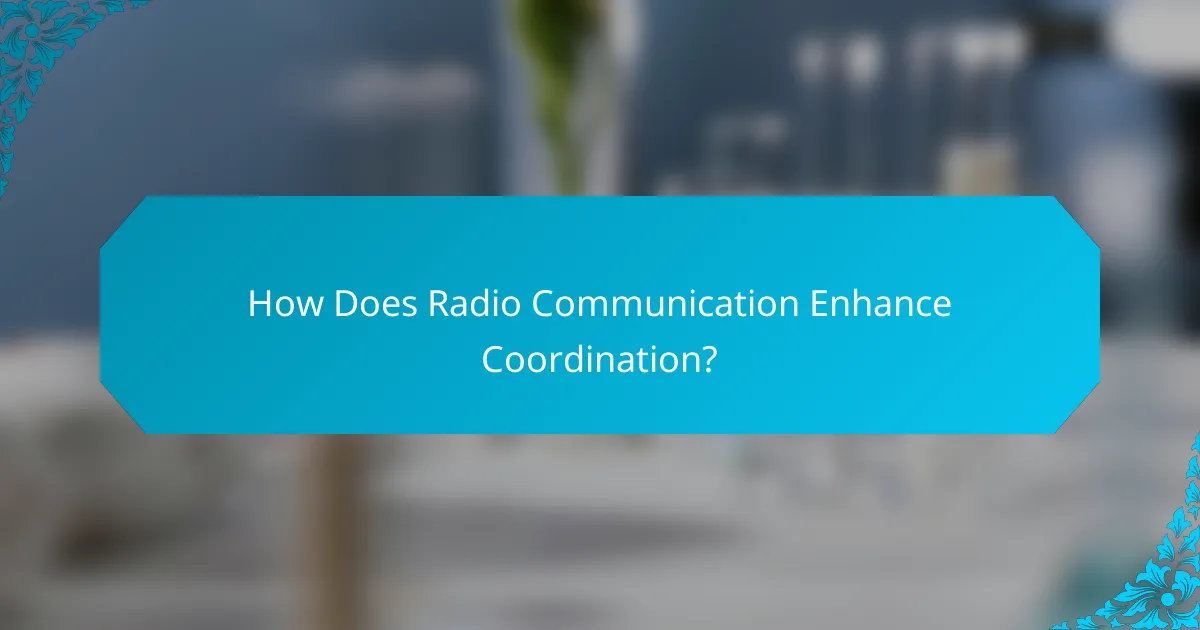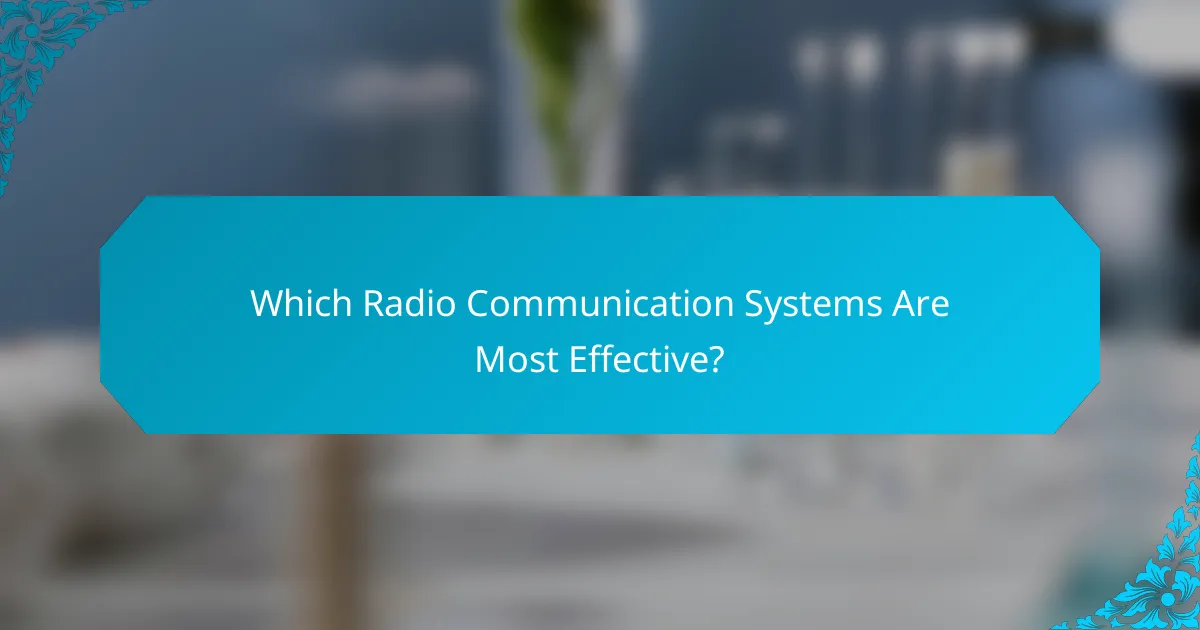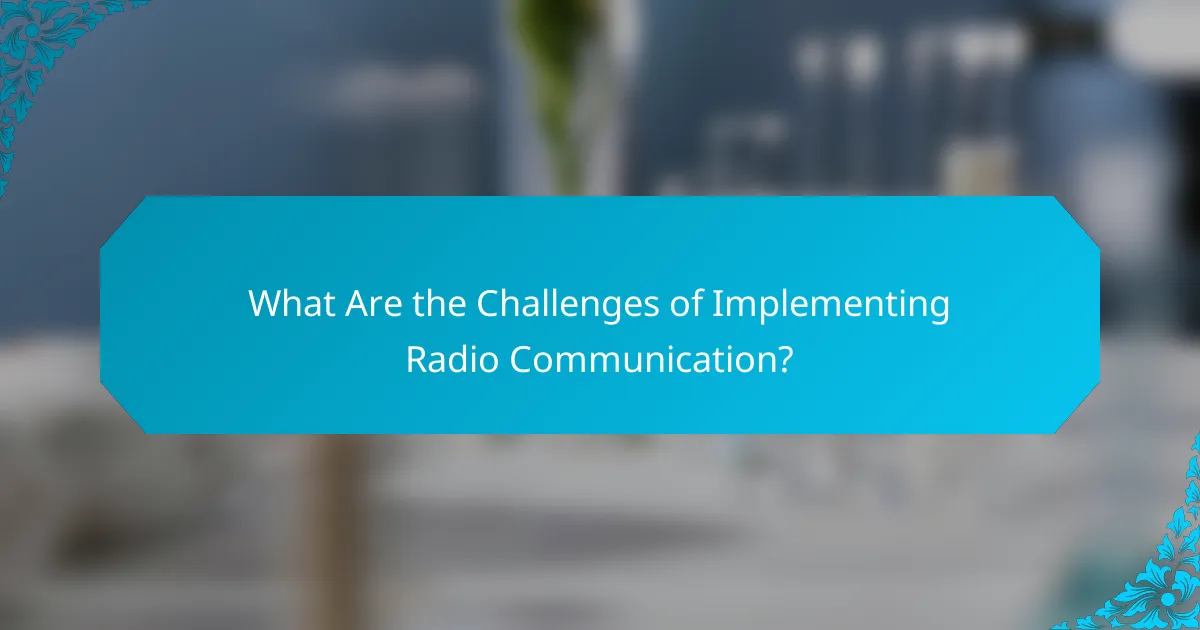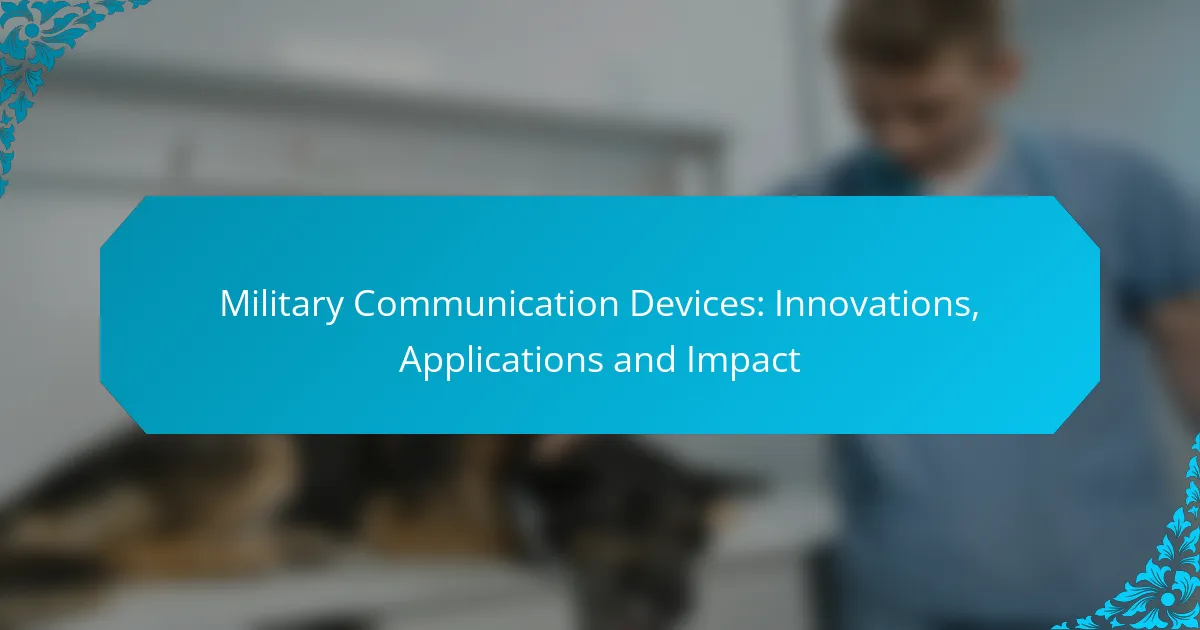Radio communication serves as a vital tool for enhancing coordination and efficiency in various operational contexts. By enabling instant connectivity among team members, it facilitates rapid information exchange and decision-making, which is crucial in high-stakes environments. The effectiveness of these systems not only improves response times but also provides a significant tactical advantage in fields such as emergency services and military operations.

How Does Radio Communication Enhance Coordination?
Radio communication enhances coordination by enabling instant connectivity among team members, facilitating efficient information exchange and decision-making. This immediacy allows teams to respond quickly to changing situations, ultimately improving operational effectiveness.
Real-time information sharing
Real-time information sharing is crucial in radio communication, allowing teams to disseminate updates instantly. This capability ensures that all members are on the same page, reducing misunderstandings and delays. For example, during an emergency response, sharing critical updates can save lives by directing resources where they are needed most.
Improved situational awareness
Radio communication significantly enhances situational awareness by providing continuous updates about the environment and ongoing operations. Teams can monitor developments and adjust strategies accordingly. For instance, in a military context, knowing the location and status of friendly and enemy forces in real-time can lead to more informed tactical decisions.
Streamlined decision-making
Streamlined decision-making is a direct benefit of effective radio communication. When information flows freely, leaders can make quicker, more informed choices. This is particularly important in high-stakes situations where every second counts, such as coordinating air support in combat scenarios.
Case studies in military operations
Numerous military operations illustrate the advantages of radio communication in enhancing coordination. For example, during Operation Desert Storm, the use of secure radio channels allowed for seamless coordination among ground and air forces, leading to a swift and effective campaign. Similarly, in peacekeeping missions, real-time communication has proven essential for maintaining safety and order in volatile environments.

What Are the Key Benefits of Efficient Radio Communication?
Efficient radio communication provides critical advantages such as improved coordination, faster response times, and better teamwork. These benefits are essential in high-stakes environments like emergency services, military operations, and event management.
Increased operational efficiency
Increased operational efficiency through effective radio communication allows teams to streamline their processes and minimize unnecessary delays. By using clear protocols and standardized language, teams can ensure that messages are understood quickly and accurately.
For instance, implementing a structured communication format can reduce the time spent on clarifying instructions, leading to smoother operations. Regular training sessions can reinforce these practices, ensuring that all team members are familiar with the communication standards.
Reduced response times
Efficient radio communication significantly reduces response times, which is crucial in urgent situations. When messages are conveyed clearly and promptly, teams can act swiftly, potentially saving lives or preventing further complications.
To achieve this, teams should prioritize concise messaging and avoid jargon that may confuse listeners. Utilizing technology such as digital radios can also enhance clarity and reduce the time needed for message transmission.
Enhanced team collaboration
Enhanced team collaboration is a direct result of efficient radio communication, fostering a cohesive working environment. When team members can communicate effectively, they are more likely to share information and coordinate their efforts seamlessly.
Regular check-ins via radio can help maintain situational awareness and ensure that everyone is aligned on objectives. Encouraging open lines of communication can also promote a culture of teamwork, where members feel comfortable sharing updates or asking for assistance when needed.

Which Radio Communication Systems Are Most Effective?
The most effective radio communication systems are those that enhance coordination, efficiency, and tactical advantage in various operational environments. Key players like Motorola Solutions, Harris Corporation, and Kenwood Communications offer distinct technologies tailored to meet diverse communication needs.
Motorola Solutions
Motorola Solutions is renowned for its robust two-way radio systems, which are widely used in public safety and commercial sectors. Their systems, such as the MOTOTRBO series, provide clear audio quality and extended battery life, making them reliable for long-duration operations.
Consider the advantages of digital trunking and integrated data applications that Motorola offers. These features enhance communication efficiency by allowing multiple users to share the same frequency without interference, which is crucial in high-density environments.
Harris Corporation
Harris Corporation specializes in advanced communication solutions, particularly for defense and government applications. Their radio systems, like the Falcon III, are designed for secure, tactical communications that can operate in challenging conditions.
When evaluating Harris products, focus on their interoperability with existing systems and compliance with military standards. This ensures seamless integration and reliable performance in critical missions, where every second counts.
Kenwood Communications
Kenwood Communications offers a range of radio systems that cater to both commercial and amateur users. Their NX series provides digital and analog modes, allowing users to transition smoothly between technologies as needed.
One key consideration with Kenwood is their emphasis on user-friendly interfaces and compact designs, which are beneficial for mobile operations. Additionally, their systems often feature built-in GPS and emergency alert functions, enhancing situational awareness in the field.

What Factors Should Be Considered When Choosing a Radio System?
When selecting a radio system, key factors include frequency range, battery life, and durability. Each of these elements plays a crucial role in ensuring effective communication in various operational environments.
Frequency range
The frequency range of a radio system determines its communication capabilities. Systems typically operate in VHF (30-300 MHz), UHF (300 MHz-3 GHz), or higher frequencies, each suited for different applications. For instance, VHF is often used for long-range communications, while UHF is preferred for urban environments due to better penetration through obstacles.
Consider the specific needs of your operation when choosing a frequency range. For example, if you require communication over long distances in open areas, VHF may be ideal. Conversely, if you are operating in a densely populated area, UHF might provide clearer signals.
Battery life
Battery life is a critical factor that affects the operational efficiency of a radio system. Most portable radios offer battery life ranging from several hours to over a day, depending on usage and power settings. Systems with higher power output typically consume more battery, so consider your communication needs when evaluating options.
To maximize battery life, opt for radios with energy-efficient features, such as power-saving modes. Regularly check battery health and have spare batteries on hand to avoid interruptions during critical operations.
Durability and weather resistance
Durability and weather resistance are essential for radios used in challenging environments. Look for radios that meet military standards, such as MIL-STD-810, which ensures they can withstand extreme temperatures, shocks, and moisture. Waterproof ratings, such as IP67, indicate a radio’s ability to resist water and dust ingress.
When selecting a radio system, consider the specific environmental conditions it will face. For outdoor operations, choose models designed to endure rain, dust, and rough handling. Investing in a robust radio can prevent costly replacements and ensure reliable communication in the field.

How Can Radio Communication Improve Tactical Advantage?
Radio communication enhances tactical advantage by enabling swift information exchange, ensuring teams can react promptly to changing situations. This immediacy fosters better coordination and decision-making in dynamic environments.
Real-time tactical updates
Real-time tactical updates allow teams to stay informed about the evolving battlefield conditions. By using radios, units can share critical information such as enemy movements, resource availability, and environmental changes almost instantly.
For effective real-time updates, establish clear protocols for communication frequency and message formats. This minimizes confusion and ensures that all team members receive the same information simultaneously.
Coordinated maneuvers
Coordinated maneuvers are essential for executing complex operations efficiently. Radio communication enables different units to synchronize their actions, whether it’s advancing on a target or retreating from a threat.
To enhance coordination, use designated channels for specific tasks, such as logistics or tactical commands. This separation helps maintain clarity and focus during operations, reducing the risk of miscommunication.
Enhanced safety protocols
Enhanced safety protocols are critical in high-stakes environments where quick decisions can save lives. Radios facilitate immediate alerts about potential hazards, allowing teams to respond effectively to threats.
Implement regular safety drills that incorporate radio use, ensuring all team members are proficient in emergency communication. This preparedness can significantly reduce response times and improve overall safety during operations.

What Are the Challenges of Implementing Radio Communication?
Implementing radio communication presents several challenges, including interference, limited bandwidth, and the need for effective coordination among users. These factors can hinder the efficiency and reliability of communication systems, especially in tactical environments.
Interference and Signal Quality
Interference from other electronic devices, environmental factors, and physical obstructions can significantly degrade signal quality in radio communication. This can lead to dropped transmissions or unclear messages, which are critical in tactical scenarios. Regular assessments of the communication environment and the use of frequency hopping or spread spectrum technologies can help mitigate these issues.
Bandwidth Limitations
Radio communication systems often face bandwidth limitations, which restrict the amount of data that can be transmitted simultaneously. This can be particularly problematic in high-demand situations where multiple users need to communicate at once. Employing efficient encoding techniques and prioritizing essential communications can optimize the use of available bandwidth.
Coordination Among Users
Effective coordination among users is essential for successful radio communication. Without clear protocols and training, users may struggle to share information efficiently, leading to confusion and delays. Establishing standardized communication procedures and conducting regular training exercises can enhance coordination and overall effectiveness.
Regulatory Compliance
Adhering to local regulations regarding radio frequency usage is crucial for legal operation. Different countries have specific rules governing the use of radio frequencies, which can affect equipment selection and operational procedures. Familiarizing yourself with these regulations and obtaining necessary licenses can prevent legal issues and ensure smooth communication operations.



